Stats, stats and more stats…. We’ve all become obsessed about statistics, haven’t we? Whether is statistics about the economy, global warning, our health or our business performance… and of course the list goes on and on. Now I’m not complaining about statistics, I love them, and I also love routine, direction and process of course!
Introduction
If your considering increasing business process automation at your organization this year… I’m hoping some of these statistics will help build your business case and accelerate your journey.
Before I discuss key the top statistics across 9 different focus areas, here's a quick reminder of how Gartner defines Business Process Automation (BPA), as the automation of complex business processes and functions beyond conventional data manipulation and record-keeping activities, usually through the use of advanced technologies.
For me, business process automation is all about using technology to bring processes online with structure for ensuring tasks are completed in a certain way.
Key Business Process Automation Statistics
1. The Process Automation Market is growing rapidly
 The growth of the Digital Process Automation (DPA) market shows no signs of slowing down, these tools are essential to today’s businesses. Here’s a few statistics from Forrester’s ‘The Low-Code And Digital Process Automation Market, 2023 To 2028’ report.
The growth of the Digital Process Automation (DPA) market shows no signs of slowing down, these tools are essential to today’s businesses. Here’s a few statistics from Forrester’s ‘The Low-Code And Digital Process Automation Market, 2023 To 2028’ report.
-
“89% of developers indicated that they had spent at least some of their development time in the past 12 months on a low-code platform — and 79% said that they use low-code, no-code, or DPA solutions.”
-
This market has had an average annual growth rate of 21% since 2019
It's A Mature Market
Digital Process Automation is an established technology market, should you have a look on Gartner Peer Insights, you’ll find 96 providers process automation tools, or a quick search in G2 shows 116 process management tools and 92 listings under Digital Process Automation.
This sheer number of vendors signifies the huge growth in mature market, which has progressed over twenty years. The 1st workflow tools that came to market in the early 1990s look very different to the innovative tools in our hands today!
2. Most Common Business Process Automation Use Cases
From regularly chatting with business process automation buyers and the FlowForma Proof of Value team, it’s apparent that there are some similarities across the types of processes that organization are prioritizing for focus.
Here are the top 3 use cases for our business process automation platform:
- 84% of our customers use the product to manage operational processes
- 67% of our customers manage finance, accounting or legal processes via FlowForma
- 58% of our FlowForma customers automate the onboarding of their employees, contractors or suppliers with the platform
Top Use Cases Identified By Forrester
Here’s what Forrester says are the primary use cases for business process management software in their ‘A Buyers’ Guide To Digital Process Automation' report.
So, we’re both seeing the top 3 use case trends as the same.
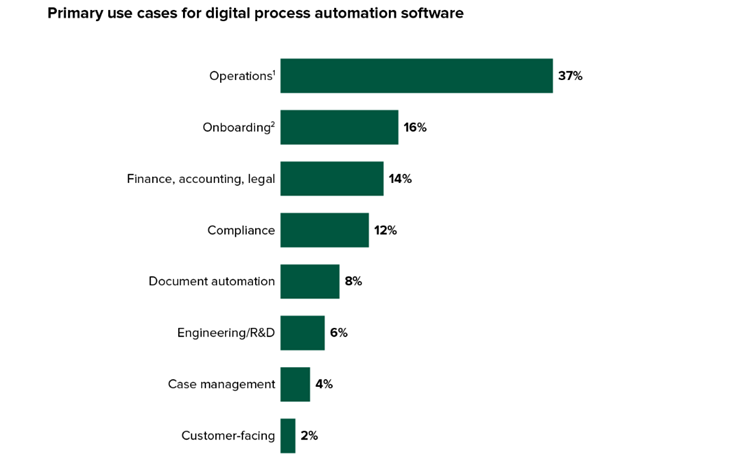
Other popular use cases that I see the community asking us about and our customers delivering results on include:
-
Compliance with health & safety and sustainability
-
Procurement is also becoming a popular use case
-
HR processes are always common pain points
-
IT processes are very widespread too
3. Sectors Focusing on Business Process Management
The Digitalization of the Energy Sector
Energy is a sector that has been trending for us in terms of business process management interest and new customers. Below are some interesting statistics about the automation of this sector:
-
According to the 'Global Digital Transformation Market in the Oil and Gas Industry 2024-2028' report The Digital Transformation in the Oil & Gas Market size is estimated to grow at a CAGR of 16.73% between 2023 and 2028.
-
The market size is forecast to increase by USD 68.64 billion. Capgemini report that by adopting intelligent automation, the industry anticipates savings of $237-$813 billion, primarily due to reduced production costs and shorter timelines.
-
The global IT spending in the oil and gas sector is projected to increase from USD 16.32 billion in 2024 to USD 22.33 billion by 2032. (Market Minds Update).
Building Workflows in Construction
We've been busy supporting construction and engineering companies over the last couple of years to automate their business processes at scale, huge progress has been made by this industry since Covid.
A survey we conducted with Construction Dive indicated that:
-
26 to 75% of their business processes were managed on paper, email or spreadsheets
-
59% of executives say improving safety is the #1 business outcome that is absolutely required in their company's project workflow.
-
33% of construction workers have difficulty engaging with external parties.
-
40% of respondents state that difficulty recruiting IT talent is a large obstacle to digital transformation.
Automation in Government Public Administration
US Chamber report entitled 'Government Digitization Transforming Government to Better Serve-Americans' states that there is a lot of business process automation needed in this sector.
Using outdated and manual processes cost government agencies an estimated $38.7 billion every year. While $143 billions spent by agencies on information collections every year, and a whopping 10.5 Billion hours spent by the public on government paperwork.
A Focus on Automation in Financial Services
A KPMG study found more than half (53%) of FS execs identified “improving business processes across the business” as the leading innovation objective for their technology function. Increasing employee productivity is the top goal for kick starting digital transformation projects in this sector. This sector has limited resources and increasing workloads, so the demand for business process automation is growing.
Common use cases in Financial services include approval processes, onboarding, anti-fraud, compliance, finance and Know Your Customer (KYC).
4. Business Process Automation Outcomes
And the most important statistics are those that our customers achieve, so kudos to our customers who have delivered the following results from process automation:
- Project Managers saving 20% of their time per day
-
Being able to take on twice the amount of work due to efficiencies
-
6,000 hours of administration saved by digitizing 5 key processes
-
40 significant processes digitized <10 weeks of onboarding
-
75% reduction in the number of emails sent on one task alone
-
50% decrease in customer complaints on one process
-
75% increase in how fast processes are deployed
5. What’s The Fastest Way To Automate Business Processes
As well as statistics, we’re all obsessing with speed too, right? From 3-minute meals, to beating your 5k personal best and relying on Google for the fastest route to the office!
Well, it doesn’t stop there, we are all demanding faster onboarding, adoption, results and ROI for our software too.
Comparing Process Vendors
I’m noticing a lot of companies doing bake-offs between competing products. For example, one of the prospects who was evaluating FlowForma versus a Microsoft PowerApps/Power Automate solution tested both platforms for the same process. We’re very proud of the result, which saw them build a complex process on the FlowForma platform in one week, compared to a staggering 4 weeks on the Microsoft platform. That’s a 3-week saving on just one process alone! This was just one of the benefits realized by adopting strategic business process automation.
Obtaining ROI Fast
On top of speed to digitalize, organizations also want fast ROI, the G2 Buyer Behaviour Report indicates that ‘78% of the respondents across EMEA, APAC, and North America said they expect an ROI within 6 months of implementing software.’
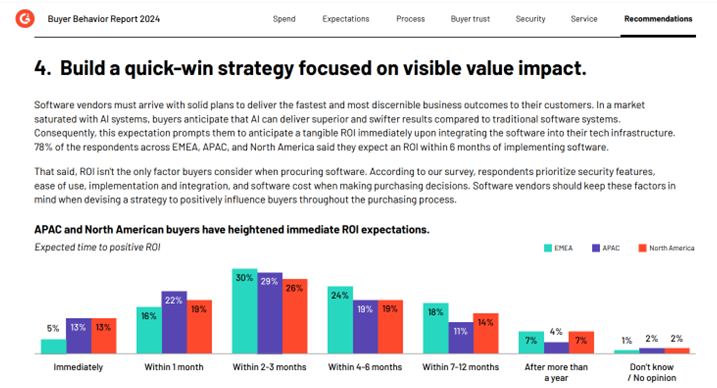
Customer Feedback
I completely agree with the desire to prove ROI fast, which is why I wanted to share a quote from a consultant who has used the FlowForma product across 3 different companies.
“Once you digitalize 3 significant processes with FlowForma Process Automation, you’ve already got your ROI,” Suzy Pinsent on using FlowForma Process Automation at Coinford, Gallagher and Hegarty’s.
From regularly chatting with our customers and our customer success team, I’m aware that most of our customers will achieve an ROI within 6 weeks of onboarding.
6. Businesspeople Want To Digitalize Business Processes
There is a growing demand from the business to digitalize and often in fusion with the IT team. According to Forrester’s Developer Survey, 62% of developers said that they completed most or all of their work in the past twelve months as part of a “fusion team” in partnership with citizen developers.
Making The Case For Citizen Development
With the global skills shortage, extraordinary demand for IT staff, and the acceleration of no code and low code digitalization tools, the trend of citizen development in increasing. John Bratincevic’s report entitled ‘The Democratization Of Development Is Accelerating 2023’ and ‘Make The Business Case For Citizen Development 2023’ has some pretty interesting statistics on this topic:
-
78% of developers at the director level and above say that their firm currently empowers employees outside of IT via a citizen developer strategy or plans to do so in the next 12 months
-
Robins & Day, a prominent auto dealership group in the UK, attributes a 23% increase in profitability on used vehicles to its citizen developer strategy
-
Shell's broad implementation of citizen development resulted in both situational savings ($35,000 from a safety equipment inspection app) and significant operational efficiencies ($3 million annually from optimizing refinery furnace trimming).
-
There is huge appetite for citizen development, an example from Shell shows that while the initial goal was to train 500 developers, they surpassed this by training over 6,500 in two years, with more than 60% actively developing thousands of apps.
-
Robins & Day saw a 10% increase in their average customer satisfaction scores due to their citizen development program.
The results of citizen development in fusion with IT are pretty phenomenal, from hours saved to cultures of continuous improvement, safer workplaces and better experiences for staff and customers.
Below you’ll find a breakdown of where 859 developers said their strategy was with regards to empowering developers outside of IT. The statistics speak for themselves.
.png?width=700&height=469&name=Citizen-Developer-Strategy-Plans-Download-Figure%20(1).png)
The same survey indicates that 75% of businesses expect non-technical people to focus on process automation or optimization tasks.
.png?width=563&height=368&name=Process-Optimization-Remains-Everyones-Job-Download-Figure%20(2).png)
7. AI
It’s not possible to write a business process automation statistics blog, and not mention AI…
In the recent ‘Forrester’s Business And Technology Services Survey, 2023’, which sought input from service decision-makers engaged in their organization’s transformation on the key activities their organization currently undertakes or will undertake as part of the transformation, the leading activity was data and AI transformation (35%). No surprise there.

The ‘AI Is Reshaping Automation Markets’ 2023 report by Craig le Clair and Bernard Schaffrik predict that that reliable real-time automation construction by LLMs won't be achievable until 2028. Nonetheless, by mid-2025, they will help direct L1 and L2 automations created with DPA, RPA, intelligent document processing (IDP), or AI platforms.

In addition, the CompTIA IT Industry Outlook report reveals that:
-
22% of firms are actively integrating AI into diverse technology products and business workflows.
-
33% of firms are implementing AI on a limited scale.
-
45% of firms are still exploring AI.
A survey conducted by Forbes Advisor also tells us that 56% of businesses are applying AI tools to enhance and perfect their operations. This matches up with the greatest area of focus for business process automation also.
A recent PEX survey also indicates a strong appetite for process automation fuelled by AI, with 100% of respondents either planning to pilot or having already undertaken AI pilots.
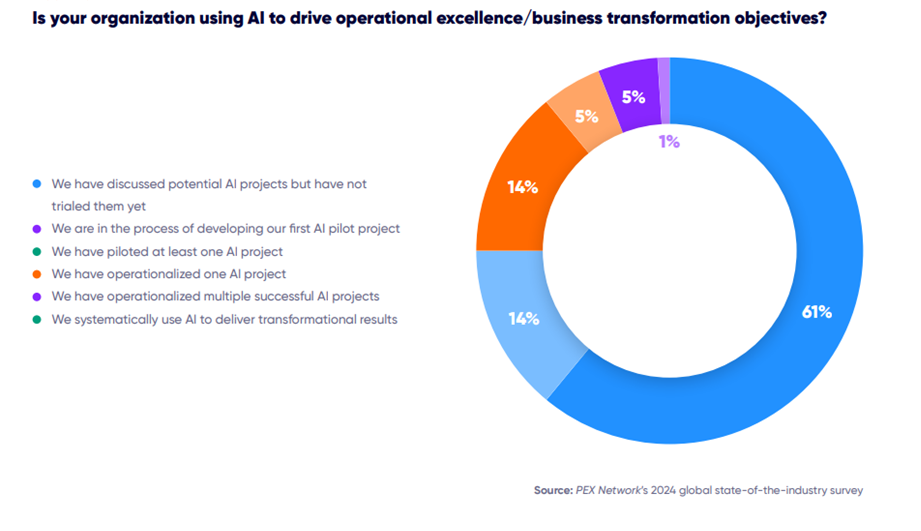
So with these statistics in mind, it’s fair to say that AI is top of mind for process automation projects.
8. The Future of Process Automation
According to Mordor Intelligence, the Process Automation Market is projected to grow from USD 13 billion in 2024 to USD 23.9 billion by 2029, with a compound annual growth rate (CAGR) of 11.6% over the forecast period.
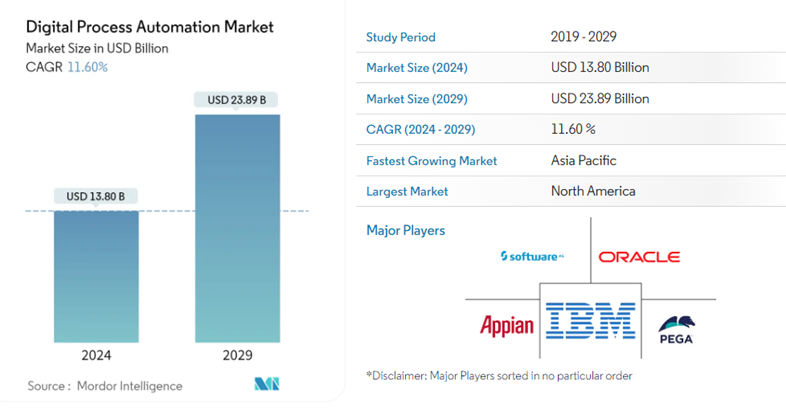
The Forrester DPA Survey Results 2023 paint a picture of what the focus of process optimization will be in September 2025, with ‘accelerating digital business transformation’ expected to be the No.1 focus of optimization efforts, followed by ‘improving customer experience’ and ‘cost reduction’ joint 2nd.

Forrester forecasts that leading companies will significantly ramp up their transformative automation initiatives, spurred by a fresh wave of AI innovation. They also predict that they will see 10% of operational processes will incorporate LLM-infused AWA digital co-workers. While over 50% of organizations currently utilize process intelligence tools, with the rest planning to adopt them soon. They also suggest that 20% of large enterprises will integrate automation into their risk registers and develop mitigation strategies for significant automation initiatives.
9. Challenges Organizations Face With Process Transformation
I recently interviewed a number of our DPA decision-makers in our community, when asked about their biggest challenge with business process automation, they said the number 1 challenge was time. This isn’t surprising given the skills shortage and the statistics from Korn Ferry that by 2030, the world will face a talent deficit of more than 85.2 million people due to the demand for skilled workers outpacing the supply.
The PEX Network’s global state-of-the-industry survey, indicates that the top 3 challenges for operational excellence and transformation are:
-
Cost/budget limitations
-
Linking process improvement with top-level business strategy
-
Integrating new systems/platforms into the organization
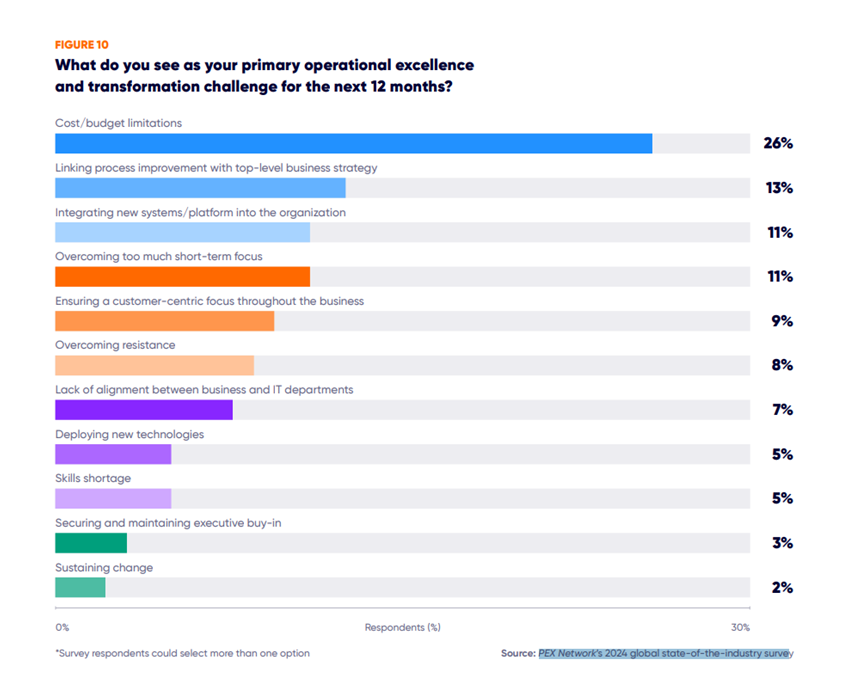
10. Current State of Business Process Automation in 2025
There is a definite appetite for process automation focus in 2025 and beyond. The chart below illustrates that 31% of respondents are focusing on workflow automation to drive operational excellence and transformation programs with a further 26% focusing on Business Process Management.
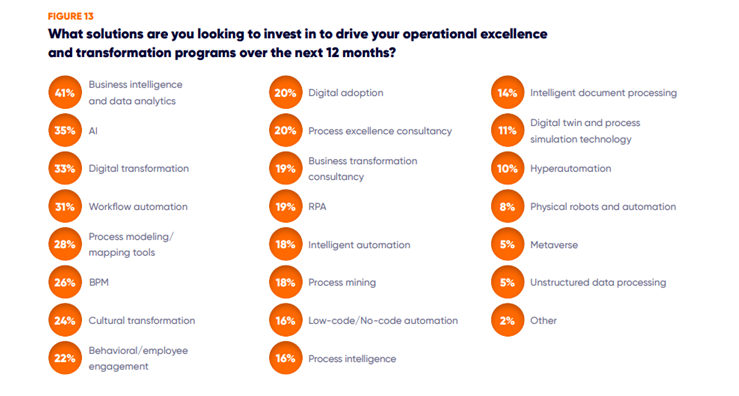
I heard a lot from our community recently that there is still a huge number of business processes managed via Excel, which are prone to error. One prospect told us they have 10,000 Excel documents being use across the business to manage processes, which is posing operational risks, with many others telling us they are anti-excel for process management. This is mirrored in survey results from Forrester, which also indicates that 82% of organizations still use paper-based, manual routing of tasks supported by Excel.

Conclusion
Well, that’s enough business process automation statistics for one day! The future of process automation looks very exciting to those who use process automation platforms and those who plan to, as well as for those who innovate the exciting features and functionalities. Low code and no code solutions will continue to grow in popularity.
Without a doubt, AI will fuel process automation interest and growth while making success for citizen developers even easier. I feel that the collaboration between business and IT teams coupled with the rise of the citizen developer will see a huge amount of value unlocked for organizations. It’s an exciting time!
Interested in learning more about FlowForma's Process Automation all-in-one (forms, workflow, analytics, document generation) platform?
Book your demo today to learn more about our award-winning platform and speak with the leading process experts.
 By
By 




